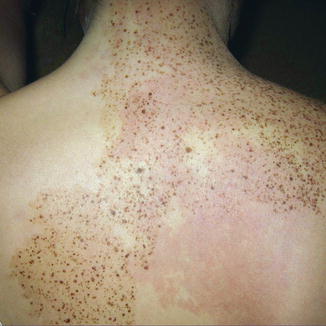(1)
Department of Dermatology, Freiburg University Medical Center, Freiburg, Germany
Abstract
Phacomatosis pigmentokeratotica can certainly be taken as a binary genodermatosis because such coexistence of papular nevus spilus and nevus sebaceus is rather often noted. This phenotype represents as an example of pseudodidymosis because both nevus sebaceus and papular nevus spilus originate form one single HRAS mutation present in a heterozygous state. Similarly, the coexistence of sebaceous nevus with melorheostosis or with aplasia cutis congenita can no longer be explained as a didymosis. – The paired occurrence of vascular and pigmentary nevi have likewise been taken as possible examples of twin spotting. Again, this assumption should today be regarded with great caution.
Molecular research has provided evidence that not all genodermatoses occurring in a binary form reflect postzygotic recombination (see Sect. 8.2). Hence, in several binary disorders the concept of didymosis cannot be upheld.
In the following group of genodermatoses that tend to occur in a binary form, the concept of didymosis is, according to present knowledge, either wrong or rather unlikely.
9.1 Phacomatosis Pigmentokeratotica: An Example of “Pseudodidymosis”
This phenotype is characterized be a papular nevus spilus coexisting with nevus sebaceus (Fig. 9.1) [14, 30, 34, 37, 41]. The disorder can be taken as a variant of Schimmelpenning syndrome [12]. Sometimes the paired nevi may occur without involvement of internal organs [8, 24, 31], but numerous cases complicated by extracutaneous defects have been reported [4, 5, 25]. The associated sebaceous nevus was reported to be particularly prone to develop multiple basal cell carcinomas [6, 27, 35], but this may reflect a bias of ascertainment. Some patients develop other malignancies [13, 21].
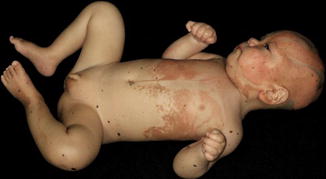

Fig. 9.1
Phacomatosis pigmentokeratotica (Courtesy of Dr. Ching-Ying Wu, Kaohsiung, Taiwan)
9.2 Paired Occurrence of Nevus Sebaceus and Melorheostosis
For heuristic reasons, an unusual case of unilateral melorheostosis coexistent with ipsilateral nevus sebaceus may be mentioned [36], although a nosological relationship is uncertain. Similar cases have so far not been reported, which is why this may be an arbitrary coincidence.
9.3 Paired Occurrence of Nevus Sebaceus and Aplasia Cutis Congenita
Aplasia cutis congenita is sometimes noted in close proximity to a sebaceous nevus (Fig. 9.2) [20], which renders a nosological relationship rather likely. A didymosis, however, as previously postulated [9, 15], can today be taken as excluded.
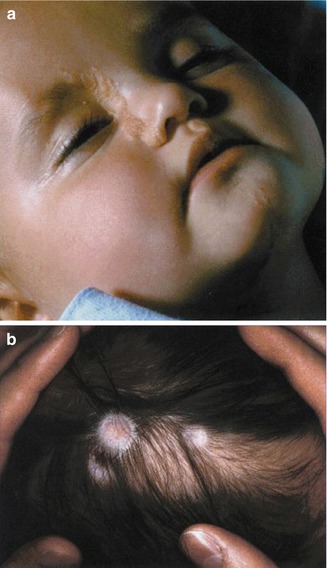

Fig. 9.2
Paired occurrence of nevus sebaceus and aplasia cutis congenita. (a) One-month-old girl with nevus sebaceus, intermingled with (b) aplasia cutis congenita on her scalp [20] (Reprinted with permission from John Wiley & Sons, USA)
9.4 Paired Occurrence of Nevus Psiloliparus and Aplasia Cutis Congenita
Another disorder that appears to be sometimes paired with aplasia cutis congenita is nevus psiloliparus (Fig. 9.3). Such binary lesions are often noted in encephalocraniocutaneous lipomatosis [26, 28, 33]. According to present knowledge, the previously proposed term “didymosis aplasticopsilolipara” [38] is inappropriate.
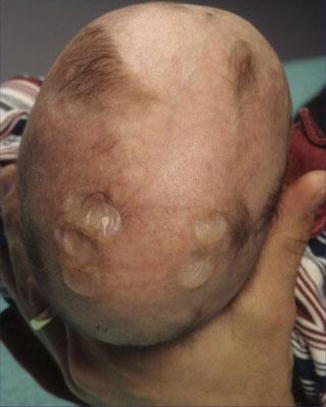

Fig. 9.3
Paired occurrence of nevus psiloliparus and aplasia cutis congenita [28] (Reprinted with permission from John Wiley & Sons, USA)
9.5 The Group of Phacomatosis Pigmentovascularis
The different types of phacomatosis pigmentovascularis had so far been taken as possible examples of nonallelic twin spotting [16, 29]. Today this concept appears to be wrong (see Sect. 3.1.1.5).
9.5.1 Phacomatosis Cesioflammea
This phenotype is characterized by a coexistence of large blue macules that are asymmetrically arranged and an extensive nevus flammeus (Fig. 9.4). Extracutaneous features include brain defects, glaucoma, asymmetry of limbs, dysplastic veins or lymph vessels, and nevus anemicus [16]. Cases of monozygotic twins discordant for the disorder [7, 29] have supported the theory of a postzygotic mutational event. The disorder was previously taken as a standard example of nonallelic didymosis [16, 32], but has recently turned out to be a “pseudodidymosis” (see Sect. 8.2).
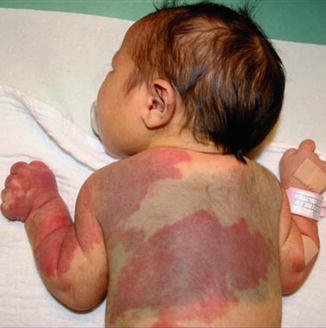

Fig. 9.4
Phacomatosis cesioflammea (Courtesy of Dr. Hansjörg Cremer, Heilbronn, Germany)
9.5.2 Phacomatosis Spilorosea
This type of phacomatosis pigmentovascularis consists of a macular nevus spilus coexisting with nevus roseus that is of a much lighter hue than nevus flammeus (Fig. 9.5) (see Sect. 7.4.1.2). Associated extracutaneous anomalies include unilateral lymphedema, cerebral defects with hemiparesis or seizures, cataracts, glaucoma, oligodontia, and asymmetry of legs giving rise to scoliosis [10, 22, 23, 38, 40].
9.5.3 Phacomatosis Melanorosea
This type is characterized by one or more large, lateralized café-au-lait macules coexistent with nevus roseus (Fig. 9.6). So far, three cases have been reported [1–3]. Aguayo et al. [1] have argued that in this type of phacomatosis pigmentovascularis, the nevus roseus may be accompanied by cutis marmorata-like lesions. Further case reports are needed to settle this question.
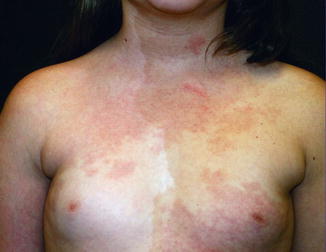

Fig. 9.6
Phacomatosis melanorosea [2] (Reprinted with permission from John Libbey Eurotext, Montrouge, France)
9.5.4 Phacomatosis Cesiomarmorata
Large aberrant Mongolian spots may also coexist with cutis marmorata telangiectatica congenita (Fig. 9.7) (see Sect. 7.4.1.4). These skin lesions may be associated with blue sclerae, hypoplastic cornea, asymmetry of hemispheres and ventricles, or hyperplasia of a limb [11, 39]. It is so far not clear, however, whether all of these cases represent a binary skin disorder rather than an arbitrary coincidence.

